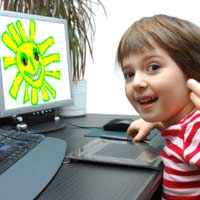Through doing this
blog assignment, I have learnt a lot from it. Before I did not how to define
technology, I though technology are all about the things that with electric
such as computer, calculator, phone, ipad, telephone, TV and etc. I never
thought about that pen can be technology, books can be technology, and scissors
can be technology. As Smorti define technology is about helping people and
solving problem (1999, pp5). Why pen is technology? Because in old days, people
used stone to write on the floor, but now we have pen to help people to write
things down on the paper. Why books are technology? Because in old days, books
only have words in black, but now a day, books are colorful and contain
pictures to support reader to understand the readings. Books are made up with very
good quality and different materials.
Through doing this
assignment, I gain a board range of knowledge about the benefit of using
different technology in children’s learning by researching articles about
technology and reading my other group members’ reflections. It changed my mind
of technology tools are for adults only. Technology can be educational for
children if used in an appropriate way. As McManis and Gunnewig (2012) identify
that whether traditional or newer educational technology plays an important
role in children’ learning when it is based on research, child development
theory, and developmentally appropriate practices.
Computer is the most
popular technology tool that common used in the centre, because computer covers
a board of learning opportunities for children, such as support and increase
children’s skills in the social, cognitive, language, literacy, writing and mathematics
realms (McManis & Gunnewig, 2012). Based on the feedback that I received
from my group members about the computer technology, they all agreed with me
that computer has positive influence on children’s social development. For
example, when children using computer, they share and help one another, ask for
and provide information and explanation and collaborate to solve problem.
In my CD player
reflection, I have a very good idea of using CD player from the feedbacks. She
mentioned that her centre is using CD player as a tool to celebrate and
acknowledge the different cultures by playing different culture music with
different language. I loved this idea of using this technology to encourage
children experience other culture. As promoting this experience for children,
it will enable children to feel positively about the diverse culture and it
also avoids the limitations of stereotyping and to value diversity within
children (Beaver, Brewster, Green, Neaum, Sheppard, Tallack, & Walker 2008).
As Te Whaariki believes children
should be encouraged to understand and respect the different cultures which
make up our society (Ministry of Education, 1996).
From the feedbacks in
my e-book reflection, one of them said that having technology in early
childhood can encourage group play and promote social interaction as much as
dramatic play. I agree with her, because e-book is interesting and attractive
technology software for children to engage with and motivate them to want to
read more (Landoni, 2009).
Overall, technology
covers a wide range of learning opportunities for children. Therefore, I will
use technology as a tool to facilitate children’s learning based on their
interests.


